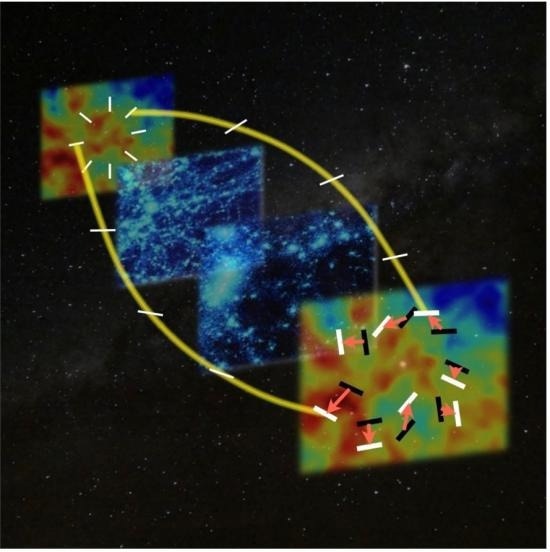A recent study published in the journal Physical Review D, designated as an Editors’ Suggestion, has indicated that forthcoming missions will achieve enhanced precision in detecting deviations from parity symmetry within the cosmic microwave background polarization.

Cosmic Microwave Background (CMB) polarized light subjected to gravitational lensing effects, in addition to cosmic birefringence. On the far left, the white lines show the polarization pattern of the CMB light generated in the early universe. These rotate due to cosmic birefringence, resulting in the currently observed CMB depicted by the black lines on the right side of the image. However, the path of light is bent by the gravitational distortion of space-time created by the large-scale structure in the middle, and so the white lines showing the polarization pattern on the right side of the image show what is observed. Image Credit: Naokawa and Namikawa
This improvement results from the diligent efforts of a pair of researchers who have factored in the gravitational lensing effect.
Cosmology endeavors to tackle profound inquiries regarding the universe's scope, origin, and inception, presenting empirical support for theoretical models based on fundamental physics. The widely accepted Standard Model of Cosmology, while notable, remains incapable of addressing fundamental enigmas such as dark matter and dark energy.
In 2020, the scientific community unveiled a fascinating phenomenon called cosmic birefringence, deduced from data on the polarization of cosmic microwave background (CMB).
Polarization characterizes the oscillation of light waves perpendicular to their direction of propagation. Ordinarily, the polarization plane remains constant, but under particular conditions, it may undergo rotation.
A re-evaluation of CMB data has proposed that the polarization plane of CMB light might have experienced a slight rotation from its origin in the early universe to the present, a transgression of parity symmetry recognized as cosmic birefringence.
The intricate nature of cosmic birefringence defies conventional physical laws, suggesting that hitherto undiscovered physics, like axionlike particles (ALPs), may underlie this phenomenon.
The discovery of cosmic birefringence holds the potential to unveil the enigmatic properties of dark matter and dark energy, thus prompting an emphasis on refining CMB observations in future missions.
To accomplish this, enhancing the precision of current theoretical calculations is pivotal. Yet, existing calculations have fallen short due to their omission of gravitational lensing.
In response, a recent study conducted by a research duo led by Fumihiro Naokawa, a Doctoral Student from The University of Tokyo's Department of Physics and Research Center for Early Universe, and Toshiya Namikawa, Project Assistant Professor from the Center for Data-Driven Discovery and Kavli Institute for the Physics and Mathematics of the Universe (Kavli IPMU).
The study has unveiled a theoretical framework for cosmic birefringence that incorporates gravitational lensing effects. Additionally, they have developed a numerical code that integrates gravitational lensing effects, which will be indispensable for future analyses.
Naokawa and Namikawa initially formulated an analytical equation delineating how gravitational lensing alters the cosmic birefringence signal.
Leveraging this equation, they integrated a novel program into an existing code to calculate gravitational lensing corrections, ultimately examining the disparities in signals with and without gravitational lensing adjustments.
Their findings reveal that disregarding gravitational lensing results in an observable cosmic birefringence signal that does not align satisfactorily with theoretical predictions, potentially rejecting the veracious theory.
Furthermore, the researchers simulated forthcoming observational data, highlighting the significance of gravitational lensing in the quest for ALPs. Their results disclosed that the omission of gravitational lensing yields significant systematic biases in the model parameters of ALPs deduced from observed data, diminishing the fidelity of the ALPs model.
The gravitational lensing correction tool introduced in this study is already in use in contemporary observational investigations. Naokawa and Namikawa are committed to its continued application in the analysis of data from future missions.
Journal Reference
Naokawa, F & Namikawa, T (2023) Gravitational lensing effect on cosmic birefringence. Physical Review D. doi.org/10.1103/PhysRevD.108.063525.